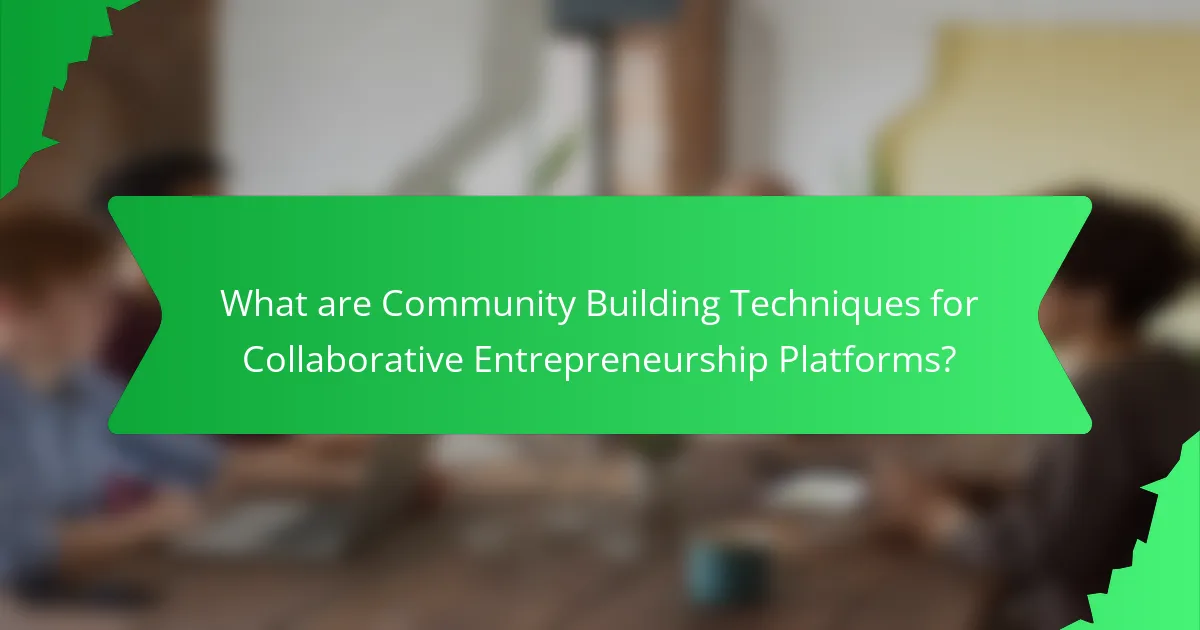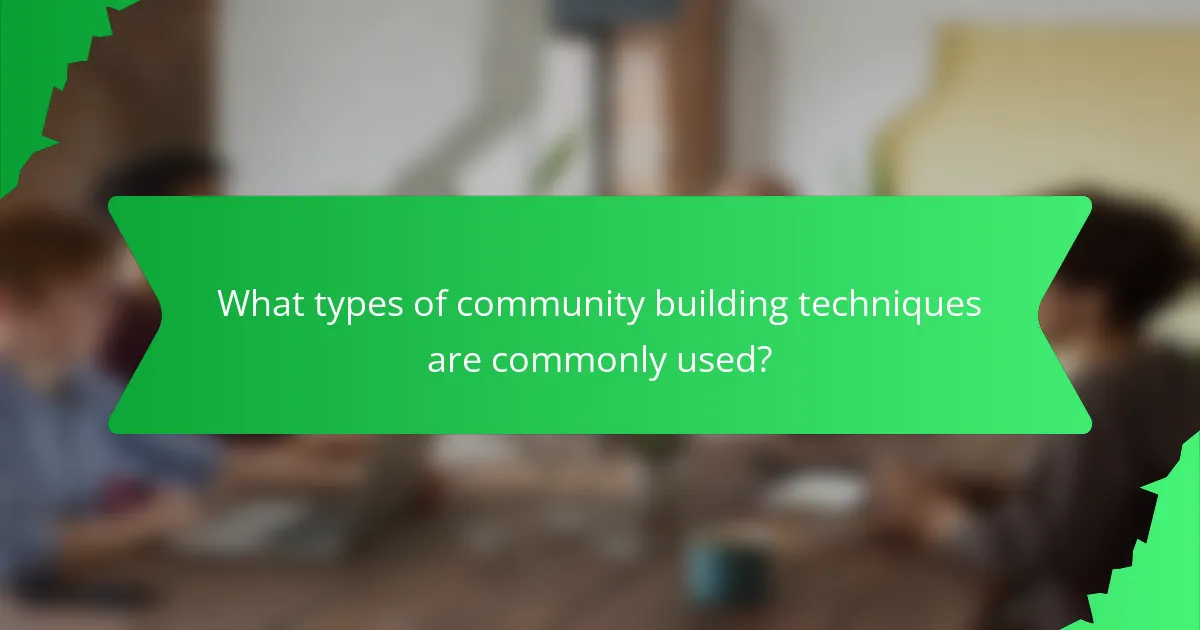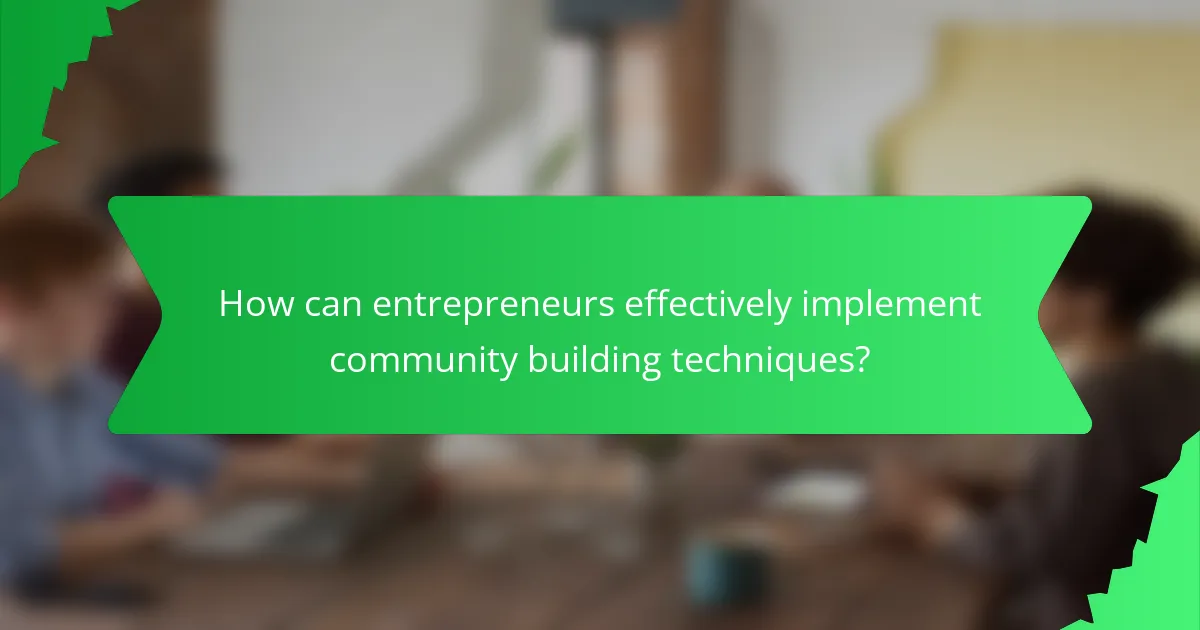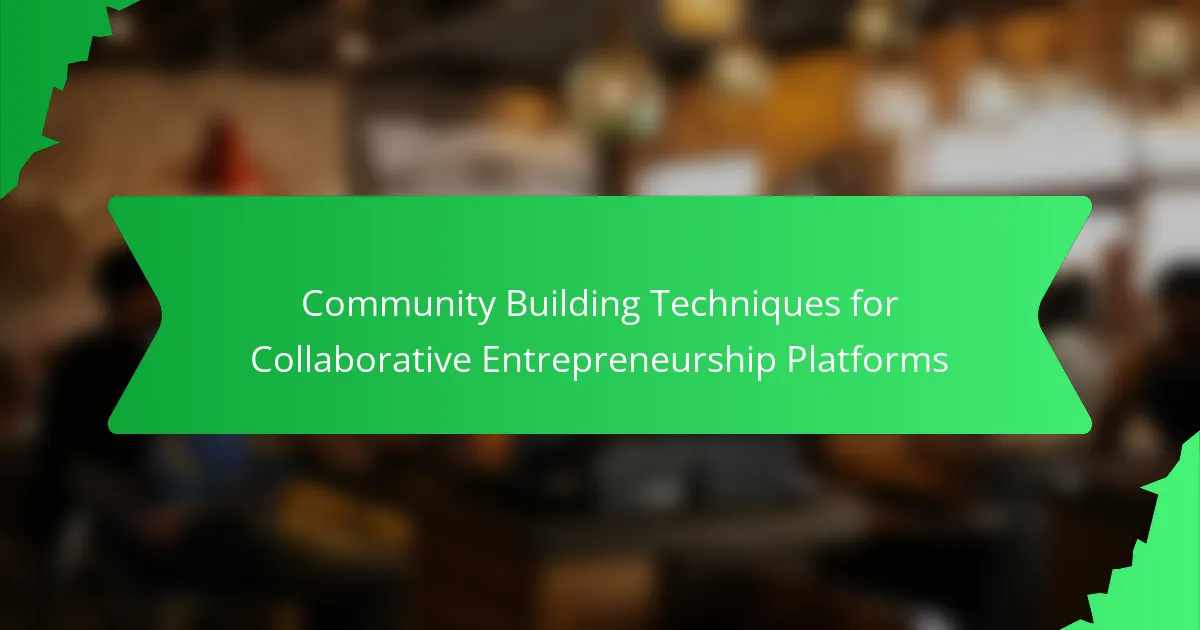Community building techniques are essential for fostering collaborative entrepreneurship platforms. Key strategies include enhancing engagement through regular communication and interactive forums, establishing shared goals to align member interests, and utilizing technology to facilitate connections. Networking events and feedback loops contribute to personal relationships and continuous improvement, while educational resources empower members with necessary skills. Techniques such as online forums, social media engagement, and local meetups further enhance involvement and loyalty, ultimately leading to higher member retention and satisfaction. Implementing these strategies effectively creates a thriving community that supports collaborative entrepreneurship.

What are Community Building Techniques for Collaborative Entrepreneurship Platforms?
Community building techniques for collaborative entrepreneurship platforms include fostering engagement, creating shared goals, and leveraging technology. Engagement can be encouraged through regular communication and interactive forums. Shared goals align members’ interests and motivate collaboration. Technology facilitates connections via online tools and platforms. Networking events enhance personal relationships among members. Feedback loops allow continuous improvement and adaptation. Educational resources empower members with knowledge and skills. Celebrating successes builds a sense of community and belonging. These techniques are essential for cultivating a thriving collaborative environment.
How do these techniques foster collaboration among entrepreneurs?
These techniques foster collaboration among entrepreneurs by creating structured environments for interaction. They facilitate networking opportunities, allowing entrepreneurs to share ideas and resources. Techniques such as workshops and mentorship programs encourage knowledge exchange. Regular meetups and online forums enhance communication among participants. Collaborative projects drive joint problem-solving and innovation. These interactions lead to stronger relationships and trust within the community. Research shows that entrepreneurs who engage in collaborative environments report higher satisfaction and success rates. This collaborative approach ultimately accelerates business growth and development.
What are the key elements of successful community building?
Successful community building requires trust, engagement, and shared purpose. Trust fosters open communication and collaboration among members. Engagement involves active participation, which can be encouraged through events and discussions. Shared purpose aligns the community’s goals with members’ interests, creating a sense of belonging. Research shows that communities with these elements see higher retention rates and member satisfaction. For example, a study by the Community Roundtable found that trust is a critical factor in community success, with 87% of respondents identifying it as essential.
How do these elements contribute to a thriving entrepreneurial ecosystem?
Elements such as collaboration, mentorship, and access to resources contribute significantly to a thriving entrepreneurial ecosystem. Collaboration fosters innovation and creates synergies among entrepreneurs. Mentorship provides guidance and support, enhancing the skills and confidence of new business leaders. Access to resources, including funding and networking opportunities, enables startups to grow and scale effectively. Research indicates that ecosystems with strong community ties see a 30% increase in startup success rates. These elements create a supportive environment that encourages risk-taking and creativity, essential for entrepreneurship.
Why is community building essential for collaborative entrepreneurship?
Community building is essential for collaborative entrepreneurship because it fosters trust and cooperation among participants. Strong relationships enhance communication and facilitate idea sharing. This leads to more innovative solutions and improved problem-solving. According to a study by the Harvard Business Review, teams with strong community ties are 50% more effective. Additionally, community support can provide resources and mentorship, which are vital for startup success. Engaging a community also increases commitment and accountability among members, driving collective progress. Thus, community building directly influences the sustainability and growth of collaborative entrepreneurial ventures.
What challenges do entrepreneurs face without a strong community?
Entrepreneurs face several challenges without a strong community. They often lack access to vital resources and support networks. This can lead to feelings of isolation and decreased motivation. Without community connections, entrepreneurs may struggle to find mentors or collaborators. Limited networking opportunities can hinder business growth and innovation. Research shows that 70% of entrepreneurs attribute their success to community support. Additionally, a weak community can result in reduced visibility and market reach. Entrepreneurs may also face difficulties in navigating challenges without shared experiences or advice from peers.
How does community support enhance entrepreneurial success?
Community support enhances entrepreneurial success by providing resources, networking opportunities, and mentorship. Entrepreneurs benefit from shared knowledge and experiences within a community. This collaboration fosters innovation and problem-solving. A supportive community can also increase visibility and credibility for new ventures. According to a study by the Kauffman Foundation, 60% of entrepreneurs credit their success to community networks. These networks facilitate access to funding and partnerships. Overall, community support creates a nurturing environment that promotes growth and sustainability for entrepreneurs.

What types of community building techniques are commonly used?
Common community building techniques include online forums, social media engagement, and local meetups. Online forums allow members to share ideas and ask questions. Social media engagement fosters real-time interaction and updates. Local meetups create personal connections and strengthen relationships. Other techniques include workshops, webinars, and collaborative projects. Workshops provide hands-on learning experiences. Webinars offer educational content to a wider audience. Collaborative projects encourage teamwork and shared goals. These techniques help to enhance community involvement and loyalty.
How can online platforms facilitate community building?
Online platforms can facilitate community building by providing tools for interaction and engagement. These tools include forums, chat rooms, and social media features. They allow users to connect based on shared interests or goals. Online platforms can also host events, webinars, and workshops to foster collaboration. These events create opportunities for networking and relationship building among users. Additionally, platforms can implement features like user-generated content and feedback systems. This encourages participation and a sense of ownership within the community. Research shows that active engagement on platforms leads to stronger community ties and increased collaboration.
What tools are available for fostering online collaboration?
Tools available for fostering online collaboration include communication platforms, project management software, and file-sharing services. Communication platforms like Slack and Microsoft Teams enable real-time messaging and video conferencing. Project management tools such as Trello and Asana help teams organize tasks and track progress. File-sharing services like Google Drive and Dropbox allow users to store and collaborate on documents seamlessly. These tools enhance team productivity and streamline workflows. Studies show that effective collaboration tools can increase team performance by up to 25%.
How do these tools enhance communication among community members?
These tools enhance communication among community members by providing platforms for real-time interaction. They facilitate discussions through chat features and forums. Members can share ideas instantly, leading to faster decision-making. Additionally, these tools often include features for file sharing and collaboration. This allows members to work together on projects seamlessly. Notifications and updates keep everyone informed about community activities. Research shows that effective communication tools can increase engagement by up to 50%. Overall, these tools create a more connected and collaborative community environment.
What offline techniques can complement online community building?
Offline techniques that can complement online community building include hosting local meetups and workshops. These events foster face-to-face interactions among community members. They encourage networking and collaboration. Additionally, organizing community service projects can strengthen bonds. Such activities enhance a sense of purpose and belonging. Furthermore, participating in local events or trade shows allows for visibility and engagement. Collectively, these offline techniques create a holistic community experience. They bridge the gap between virtual and physical interactions, enhancing overall community cohesion.
How do networking events contribute to community growth?
Networking events enhance community growth by fostering connections among individuals. These events provide opportunities for participants to meet and interact. Increased interaction leads to the formation of relationships. Stronger relationships promote collaboration on projects and initiatives. Collaborations can result in shared resources and knowledge. This exchange of ideas can drive innovation within the community. Additionally, networking events often attract diverse participants, enriching the community’s cultural fabric. Research shows that communities with active networking initiatives experience higher levels of engagement and support.
What role do mentorship programs play in building a supportive community?
Mentorship programs play a crucial role in building a supportive community. They facilitate knowledge sharing between experienced individuals and newcomers. This exchange fosters personal and professional growth. Mentorship enhances networking opportunities within the community. Participants often feel a greater sense of belonging and support. According to a study by the National Mentoring Partnership, mentees are 55% more likely to enroll in college. Furthermore, mentorship programs can increase retention rates in various organizations. They create a culture of collaboration and mutual assistance. This ultimately strengthens the community as a whole.

How can entrepreneurs effectively implement community building techniques?
Entrepreneurs can effectively implement community building techniques by fostering engagement and creating value for members. They should establish clear communication channels, such as forums or social media groups. Regularly hosting events, both online and offline, encourages interaction among members. Providing resources and support enhances the community’s value. Encouraging feedback helps tailor the community to members’ needs. Collaborating with local organizations can broaden reach and impact. Research shows that engaged communities lead to higher retention rates and satisfaction. According to a study by the Community Roundtable, organizations with strong community engagement see a 50% increase in member retention.
What best practices should entrepreneurs follow for community engagement?
Entrepreneurs should prioritize transparency, authenticity, and active participation for effective community engagement. Transparency builds trust; sharing goals and challenges encourages community members to connect. Authenticity fosters genuine relationships; being true to values attracts like-minded individuals. Active participation involves regular interactions; hosting events or discussions keeps the community engaged. Additionally, entrepreneurs should listen to feedback; it helps refine strategies and shows members their opinions matter. According to a 2022 survey by the Community Roundtable, 76% of community members value responsiveness from leaders. Implementing these practices can lead to stronger community ties and enhanced collaboration.
How can entrepreneurs measure the success of their community initiatives?
Entrepreneurs can measure the success of their community initiatives through various metrics. They can track community engagement levels, such as participation rates in events or online discussions. Surveys can provide feedback on community satisfaction and perceived value. Additionally, monitoring social media interactions can indicate community growth and sentiment. Tracking the number of collaborations or partnerships formed can also reflect initiative success. Data analysis tools can quantify these metrics effectively. According to a study by the Stanford Social Innovation Review, measuring impact through qualitative and quantitative data enhances understanding of community initiatives.
What strategies can be used to sustain community involvement over time?
To sustain community involvement over time, regular engagement activities must be implemented. These activities can include workshops, webinars, and social events that encourage participation. Consistent communication through newsletters and social media keeps members informed and connected. Establishing leadership roles within the community fosters a sense of ownership among members. Providing recognition for contributions enhances motivation and commitment. Additionally, gathering feedback and adapting strategies based on member needs ensures relevance. Research shows that communities with active involvement strategies retain members more effectively. According to a study by the National Community Development Association, communities that engage members regularly see a 30% increase in retention rates.
What common pitfalls should entrepreneurs avoid in community building?
Entrepreneurs should avoid several common pitfalls in community building. One major pitfall is neglecting audience engagement. Engaging with community members fosters loyalty and participation. Another pitfall is failing to define clear goals. Without specific objectives, community efforts can become unfocused.
Ignoring feedback is also detrimental. Feedback helps entrepreneurs understand community needs and improve their approach. Additionally, underestimating the importance of diversity can limit perspectives and innovation. A diverse community encourages a richer exchange of ideas.
Inconsistent communication is another issue. Regular updates and interactions keep the community informed and connected. Lastly, overlooking conflict resolution can lead to unresolved issues. Addressing conflicts promptly maintains a healthy community dynamic.
How can miscommunication impact community dynamics?
Miscommunication can significantly disrupt community dynamics. It can lead to misunderstandings among members. These misunderstandings may result in conflict or tension. When individuals misinterpret each other’s intentions, trust can erode. This erosion of trust can hinder collaboration. A study by the Harvard Business Review found that effective communication boosts team performance. Conversely, poor communication can decrease productivity by up to 25%. Miscommunication also limits the sharing of ideas and resources. Ultimately, this can stifle innovation within the community.
What are the risks of neglecting community feedback?
Neglecting community feedback can lead to significant risks for organizations. First, it can result in a disconnect between the organization and its community. This disconnect may cause a lack of trust and engagement among community members. When feedback is ignored, community members may feel undervalued. This feeling can lead to decreased participation and support for initiatives.
Additionally, neglecting feedback can result in poor decision-making. Organizations may implement strategies that do not align with community needs. This misalignment can lead to wasted resources and missed opportunities. Furthermore, ignoring feedback can harm the organization’s reputation. Negative perceptions can spread quickly within communities, leading to a loss of credibility.
Ultimately, the risks of neglecting community feedback can hinder growth and sustainability. Engaging with community feedback is essential for fostering collaboration and innovation.
What practical steps can entrepreneurs take to enhance their community building efforts?
Entrepreneurs can enhance their community building efforts by actively engaging with their audience. This includes hosting regular events to foster interaction. Utilizing social media platforms for consistent communication is essential. Creating valuable content that addresses community needs also strengthens connections. Encouraging feedback helps tailor initiatives to member interests. Collaborating with local organizations can expand reach and resources. Offering incentives for participation can motivate community involvement. Tracking engagement metrics allows for adjustments to improve strategies.
Community Building Techniques for Collaborative Entrepreneurship Platforms focus on fostering engagement, creating shared goals, and leveraging technology to enhance collaboration among entrepreneurs. Key elements include trust, active participation, and mentorship, which contribute to a thriving entrepreneurial ecosystem. The article outlines practical techniques, such as online forums, networking events, and workshops, that facilitate community involvement and support. Additionally, it addresses the importance of feedback, communication tools, and the risks of neglecting community input, providing a comprehensive overview of effective strategies for building a strong entrepreneurial community.
